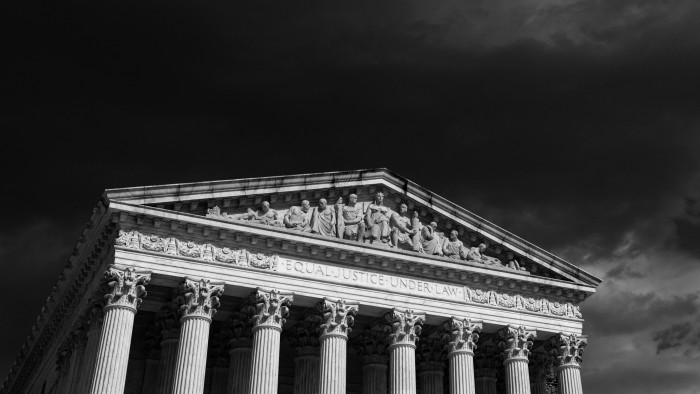Even amid a tumultuous present, it is difficult to imagine a radically different future. But the fortunes of nations do change, often dramatically. Politics has consequences. For this reason, it pays to think creatively about what these consequences might be — and about how we might look to those living with them.
As an economist used to studying growth and stagnation over the long term, I can picture myself assessing American history in 2050 (assuming I am still alive and not senile by then). This story, of course, is yet to be told. But it could go something like this.
The decline, when it came, was sudden and unexpected. The 20th century had been the American century and the US looked even more unstoppable in the first decades of the 21st. As it took the lead in artificial intelligence, its economy appeared robust and destined to outperform western European rivals that were still suffering the effects of the 2007-09 financial crisis and the Covid pandemic of 2020-22. China was a more formidable rival, but many commentators had begun dismissing the possibility that it would overtake the US. It came as a surprise to most when, in the early 2030s, the US economy stopped growing and fell behind even compared to Europe.
Historians and journalists have been debating what happened ever since. Some focused on the economic policies of Donald Trump’s second term: tariffs on allies that, after some back-and-forth, started a global trade war that damaged rather than helped US manufacturing and caused a spike in inflation; and further tax cuts for corporations and high-income Americans that increased the federal debt from an already massive $36tn to more than $50tn.

Others saw the “government-tech complex” that emerged in Trump’s second term as the real culprit. With all AI and cryptocurrency regulations lifted and the Trump Department of Justice declaring that it would not apply any antitrust pressure, the tech industry consolidated further and a few mega-corporations came to dominate the entire sector. This not only slowed down new useful innovations, but laid the seeds of the big tech crash of 2030, when trillions of dollars were wiped off the economy as it became clear that most of the huge investment in AI wasn’t paying off.
Another school of thought contended that the rot had begun with the 46th president, Joe Biden, under whose watch inflation surged, the federal debt jumped up and regulations became more politicised and stifling for businesses — something that, despite his promises, Trump never reversed. Instead, the newly created Department of Government Efficiency (Doge), run by Trump’s ally Elon Musk, focused on firing and intimidating civil servants sympathetic to the previous administration. This didn’t do much to improve the business environment or competitiveness, but further weakened oversight of corruption.
A basic pillar of the American century was the country’s ability to shape the world order in a way that was advantageous for its own economy, including for its financial and tech industries. But the US withdrawal from the Paris Accords and the World Health Organization and the onerous tariffs imposed on allies, followed by infighting within Nato, prompted more and more countries to move away from the dollar and US financial system as their anchor.
None of these explanations were sufficient to account for the sudden, unexpected decline, however. The most significant was the crumbling of American institutions. This happened both because of structural problems that long predated Biden and Trump, and also, importantly, because the actions of both presidents crushed belief in these institutions.
American economic success in the era after the second world war depended on innovation, which in turn relied on strong institutions that encouraged people to invest in new technologies, trusting that their inventiveness would be rewarded. This meant a court system that functioned, so that the fruits of their investments could not be taken away from them by expropriation, corruption or chicanery; a financial system that would enable them to scale up their new technologies; and a competitive environment to ensure that incumbents or rivals couldn’t block their superior offerings. These kinds of institutions matter under all circumstances, but they are especially critical for economies that rely heavily on innovation.

Stability requires that people trust institutions, and institutions become more likely to fail when people think they are failing. This is what explained the sudden meltdown of US economic dynamism.
Cracks were never absent in US institutions, which for most of their history had disenfranchised and discriminated against Black Americans and at times, such as during the turn of the 20th century, were captured by the wealthy and by large corporations. All the same, many citizens in the 1950s and 1960s believed in the American dream and American democracy.
Democracy’s bargain everywhere, and especially in the US, was to provide shared prosperity (economic growth out of which most people benefited), high-quality public services (such as roads, education, healthcare) and voice (so that people could feel they were participating in their own government). From around 1980 onwards, all three parts of this bargain started to fall away.
Economic growth in the US was rapid for most of the post-1980 era, but about half of the country didn’t benefit much from this. In a pattern unparalleled in the industrialised world, Americans with less than a college degree experienced a real (inflation-adjusted) decline in their wages between 1980 and 2013, while those with postgraduate degrees experienced robust growth.
It wasn’t only income. Postgraduates and those in specialised “knowledge” occupations increased their social standing relative to blue-collar workers and traditional office employees. Many regions of the country were gripped by long-lasting recessions as cheap imports from China and new technologies destroyed jobs, while major coastal, globally hyperconnected metropolitan centres continued to flourish. Another dimension of inequality was similarly jarring: a rapidly multiplying number of multibillionaires, not just flaunting their wealth but exercising ever greater influence over politics and people’s lives.

Many Americans felt that they no longer had much of a political voice. In surveys, more than 80 per cent started saying that politicians did not care about what people like them thought. They also reported incredibly low levels of trust in all branches of government, in courts, in the police and in the bureaucracy. Some of this discontent was manufactured in social media and on talk shows. But some of it was real, as on many issues politicians did not accommodate the views of large numbers of voters. For example, for a long time neither Democrats nor Republicans engaged with intensifying concerns that some voters had with illegal immigration, creating an environment ripe for demagogues and extremists to grab the spotlight.
But perhaps the most important determinant of this dwindling trust in institutions was that the US had become much more polarised, making it increasingly difficult to satisfy the majority of the voters. The flames of grievance were powerfully fanned by social media, which deepened polarisation. This then further reduced trust in democracy and in public institutions. Worse, with intensifying distrust, something essential to democracy — compromise — became more and more challenging.
By the 2010s something unprecedented was happening. Ever since data on this had been collected, an overwhelming majority of Americans saw democracy as the “only game in town” and gave it strong support relative to alternatives such as monarchy, military dictatorship or rule by unelected experts. That began changing, especially among young people, who reported growing scepticism about democracy and much more lukewarm support for these institutions.
The cracks were visible long before Trump was first elected in November 2016. He was in many ways a symptom of those troubled times. Voters can be gullible. But their willingness to support outsiders, often with very little preparation or qualification for national office, correlates with deep discontent with the existing state of affairs and a belief that the system needs to be shaken up. One fundamental problem was that political operatives and business elites opposed to Trump never understood him in this way.
In this environment, Trump quickly transitioned from being a symptom to being a cause, repeatedly breaking with democratic norms and refusing to abide by the constraints that laws and precedents set on presidential behaviour.
Joe Biden was elected as president in November 2020 in part to restore stability to US institutions and strengthen democracy. He boasted that in its first 100 days, his administration “acted to restore the people’s faith in our democracy to deliver”. But polarisation took its toll on Biden’s presidency.
Democratic party activists interpreted the 2020 election results as a mandate to adopt a radical agenda of social change throughout US society, some of it starting in federal or local governments and some of it emanating from universities and non-governmental organisations, though empowered by the knowledge that the party in government favoured this agenda. Biden was arguably too weak or too beholden to the various parts of his coalition to chart a different course. For many, much of this felt like top-down social engineering, and was one of the factors that brought Trump back to power in 2025. He was once again a symptom of the times, elected despite being recognised by many as volatile, polarising and a convicted felon.

Trump’s second term therefore turned out to be more damaging to US institutions than his first, not just because he had been radicalised himself and came to power more prepared. It was also because the times were different.
Turning points are useful to locate because they are symbolic of deeper causes of social change. In hindsight, an obvious turning point came just before Trump’s second inauguration. Biden, who had four years ago made defence of democracy a main agenda item, pre-emptively pardoned his family and a number of politicians and public servants, including former Republican Congresswoman Liz Cheney and the former medical adviser to the president, Anthony Fauci. The optics were clear and ugly: Biden and his camp by this point had so little trust in US institutions that they thought only such pre-emptive pardons could stop Trump’s retribution (and making the reality worse than the optics, it was only the enemies of Trump who were close to Biden that counted).
Symbols matter, especially when it comes to institutions. Once it becomes accepted that institutions are not functioning and cannot be trusted, their slide intensifies and people are further discouraged from defending them. We could see this dynamic already in the late 2000s, interwoven with polarisation. Trust in institutions took a severe beating after the financial crisis of 2007-09, precisely because the conceit of a well-regulated, expertly run economy came crashing down. Understandably, many Americans reacted negatively when the government rushed to rescue banks and bankers while doing little to help homeowners in bankruptcy or workers who had lost their jobs. The inequalities that had formed became much more visible, partly because the lavish lifestyles of the bankers rescued by the government became a symbol for the gulf that had opened between regular working people and the very rich.
Similarly, the critical state of US institutions became much clearer after Biden’s cynical pardons, sending a signal to millions that his administration’s defence of democracy was a charade.
The damage to democracy thus began even before Trump ascended to power the second time. From there it deteriorated following a bewildering series of executive orders and initiatives, mostly aimed at weakening democratic institutions (for example, appointing unqualified loyalists to key posts and freeing violent participants of the January 6 Capitol attack) and firing non-loyal personnel from the civil service.
While Trump’s domestic agenda intensified the loss of trust in US institutions and expertise in government, his relations with foreign allies did the same for the so-called rules-based order. Of course, there was some truth to critics’ contention that these rules were designed for America’s benefit and that when they didn’t serve it well, they were bent or broken by US politicians, diplomats and companies. But the world was not ready for Trump’s tariffs, threats and military expansionist rhetoric towards Panama, Greenland and even Canada.
This set the scene for a series of catastrophic governmental failures. With morale gone and key personnel fired, the US state was ill-equipped to deal with emergencies. When new pandemics arrived, the response was haphazard, and unpreparedness cost tens of thousands of lives. The few remaining independent media sources uncovered a glaring and dangerous lack of oversight of critical infrastructure, including nuclear reactors and cyber security.

But the real extent of the damage became clear only with the tech meltdown of 2030. Economists and historians have now shown that a lot of this was the outcome of institutional failures and growing concentration in the industry. After Trump lifted all roadblocks ahead of AI acceleration and cryptocurrency speculation, there was initially a boom in the tech sector. But within a few years the industry had become even more consolidated than before, and both insiders and outsiders came to realise that only companies favoured by the administration could survive.
Gargantuan incumbents began crushing rivals, first by using their financial might, then by luring competitors’ workers and innovators (who curiously stopped producing valuable patents once they had joined these mega-firms) and ultimately by stealing their intellectual property. By this point, US courts had lost most of their objectivity, and because the mega-firms were the administration’s friends and allies, they benefited from favourable rulings even when they were blatantly stealing from smaller competitors and engaging in predatory pricing and vertical foreclosure to drive them out of the market.
By late 2029, many commentators were questioning what was going on in the tech industry, which had invested heavily in AI but had little to show for this in terms of innovation or productivity growth. There was huge enthusiasm and investment in cryptoassets, which were one by one revealed to be scams costing regular Americans billions of dollars. The AI empire had no clothes by this point, because the competitive energy had been sucked out of it. It took a while longer for the market to realise that, but when it did, a massive stock market crash followed.
This is the kind of shock that a dynamic economy can recover from, with new innovators coming in, government experts using fiscal policy and other interventions to prevent the crash from translating into a deep recession, and all sorts of people still believing in their ability to make a difference. But once malaise about US institutions had sunk in and experts were no longer around in the government, the crash became a recession and then a depression.
The depression continued and intensified. Many now understood that institutions needed to be fixed, but after the damage that Biden and Trump had done and the polarisation that had reached even higher peaks, rebuilding them proved difficult. American innovators and scientists started emigrating to Canada and the European Union. Some even went to China.
America’s collapse thus followed Hemingway’s famous line on bankruptcy. It happened gradually, as shared prosperity, high-quality public services and the operation of democratic institutions weakened, and then suddenly, as Americans stopped believing in those institutions.
Looking back from 2050, however, one thing is clear. This was all avoidable. There were many points at which institutions could have been bolstered, compromises reached and extremists kept at bay. American politicians and activists failed. Perhaps Americans got the politicians and the activists they deserved. At the very least, they did nothing to prove that they deserved better.
Daron Acemoglu is a professor at the Massachusetts Institute of Technology and a winner of the Nobel Prize in economics
Find out about our latest stories first — follow FT Weekend on Instagram and X, and sign up to receive the FT Weekend newsletter every Saturday morning







